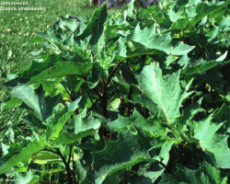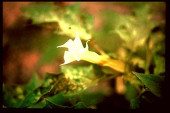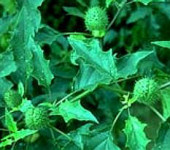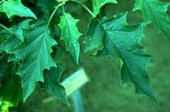Datura spp.(Jimsonweed, Downy Thornapple, Devil's Trumpet, and Angel's Trumpet)

This page is part of the CU Toxic Plant Pages and was constructed by Jamie Jonker.
[Names - Scientific and Common]
[Desription of Jimsonweed]
[Distribution of Jimsonweed]
[Control of Jimsonweed]
[Toxic properties of Jimsonweed]
[Clinical signs of poisoning from Jimsonweed]
[Jamestown Story]
[References]
Scientific Name
Datura Stramonium L. - Named by Carl Linnaeus as published in Species Plantarum (1753). The genus was derived from ancient hindu word for plant, dhatura. The species name is from New Latin, stramonium, meaning thornapple. Stramonium is originally from from Greek, strychnos (nightshade) and manikos (mad).
Common Names of Plants in Datura spp:
- Jimsonweed
- Jamestown weed
- Thorn Apple
- Downy Thornapple
- Devil's Trumpet
- Angel's Trumpet
- Mad Apple
- Stink Weed
- Tolguacha
Jimsonweed is an annual herb which grows up to 5 feet tall. It has a pale geen stem with spreading branches. Leaves are ovate with green or purplish coloration , coarsely serrated along edges, and 3 to 8 inches long. Flowers are white or purple with a 5-pointed corolla up to four inches long and set on short stalks in the axils of branches. Seeds are contained in a hard, spiny capsule, about 2 inches in diameter, which splits lenghtwise into four parts when ripe.



Jimsonweed is a cosmopolitan weed of worldwide distribution. It is found in most of the continental US from New England to Texas, Florida to the far western states. Jimsonweed is found in most southern Canadian Provinces as well. It gows in cultivated fields being a major weed in soybeans worldwide. Jimsonweed is common on overgrazed pastures, barnyards, and waste land preferring rich soils.
Because of Jimsonweed's toxic properties, the custom of destroying the plant should be practiced on every farm. Animals should not be allowed to graze on sparse pasture inhabited by Jimsonweed. Hay and silage should not be made from fields until all Jimsonweed has been removed. Soybean and other grain fields infested with Jimsonweed can be controlled by a variety of broadleaf herbicides.
Note that herbicides should be applied as directed by a qualified applicator.
All parts of Jimsonweed are poisonous. Leaves and seeds are the usual source of poisoning, but are rarely eaten do to its strong odor and unpleasant taste. Poisoning can occur when hungry animals are on sparse pasture with Jimsonweed infestation. Most animal poisoning results from feed contamination. Jimsonweed can be harvested with hay or silage, and subsequently poisoning occurs upon feeding the forage. Seeds can contaminate grains and is the most common poisoning which occurs in chickens.
Poisoning is more common in humans than in animals. Children can be attracted by flowers and consume Jimsonweed accidentally. In small quantities, Jimsonweed can have medicinal or haulucinagenic properties, but poisoning readily occurs because of misuse. Ingestion of Jimsonweed caused the mass poisoning of soldiers in Jamestown, Virginia in 1676.
Jimsonweed toxicity is caused by tropane alkaloids. The total alkaloid content in the plant can be as high as 0.7%. The toxic chemicals are atropine, hyoscine (also called scopolamine), and hyoscyamine.
Jimsonweed poisoning occurs in most domesticated production animals: Cattle, goats, horses, sheep, swine, and poultry. Human poisoning occurs more frequently than livestock poisoning making jimsonweed unusual among most poisonous plants.
Early Signs:
- rapid pulse
- restlessness
- polydipsia
- depression
- rapid breathing
- nervousness
- dilated pupils
- muscular twitching
- frequent urination
- diarrhea
- anorexia
- weight loss
Fatal Cases:
- weak pulse
- irregular breathing
- lower body temperature
- coma
- retained urine
- convulsions

Captain John Smith, founder of Jamestown
In 1676, British soldiers were sent to stop the Rebellion of Bacon. Jamestown weed (Jimsonweed) was boiled for inclusion in a salad, which the soldiers readily ate. The hallucinogenic properties of jimsonweed took affect.
As told by Robert Beverly in The History and Present State of Virginia (1705): The soldiers presented "a very pleasant comedy, for they turned natural fools upon it for several days: one would blow up a feather in the air; another would dart straws at it with much fury; and another, stark naked, was sitting up in a corner like a monkey, grinning and making mows at them; a fourth would fondly kiss and paw his companions, and sneer in their faces with a countenance more antic than any in a Dutch droll.
"In this frantic condition they were confined, lest they should, in their folly, destroy themselves - though it was observed that all their actions were full of innocence and good nature. Indeed they were not very cleanly; for they would have wallowed in their own excrements, if they had not been prevented. A thousand such simple tricks they played, and after 11 days returned themselves again, not remembering anything that had passed."
Brown, D. Jimsonweed. Cornell University. WWW Page.
Mitch, L.W. 1989. Jimsonweed. Weed Technology. 3:208-210.
Munro, D. 1996. Jimsonweed. Canadian Poisonous Plants WWW Page.
Williams, M. 1995. Jimsonweed. University of Illinois. WWW Page.
Datura spp. WWW Links
University of Illinois Poisonous Plants - Jimsonweed